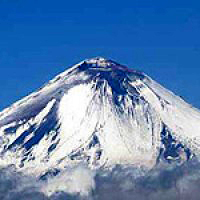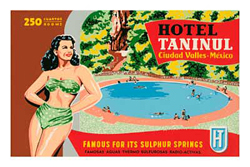1. Mexico is the largest Spanish-speaking country in the world. What is the the most spoken indigenous or dialect language?
a. Mayan
b. Zapotec
c. Nahuatl
2. What description below best fits an example of Spanglish?
a. A truck is: “an una troca”
b. A book is: “el libro”
c. Estoy is: “I am”
3. What is the official language of Mexico?
a. Mexicana
b. el castellano
c. mestizaje
d. español
LAND
1. What volcano in Mexico is closed to climbers because of imminent risk of eruption?
a. Popocatepetl
b. Ixtaccihuatl
c. Citlaltepetl
2. Mexico has more of these than any other country of the Americas, south of the US border:
a. volcanoes
b. mountains
c. beaches
d. palm trees
3. Which of these towns is on the “Mexican Riviera”?
a. Tijuana
b. Cancún
c. Puerto Vallarta
FOLKLORE
1. What famous product made in the 1400’s of fig bark, still survives today as an art form?
a. la piñata
b. miguelitos
c. papel amate
d. carved wooden masks
2. The famous danza de los voladores is a tradition of pole flying to ask the gods to bring:
a. peace
b. prosperity
c. rain
d. purging of disease
3. What is the name of the Puebla dress for folkloric dance designed from the dress of a captured foreign princess in the late 1600’s who was sold as a slave to her Spanish captain?
a. la quinceañera
b. China Poblana
c. rebozos
RELIGION
1. Who is the most powerful protector and intercessor for a Mexican?
a. St. George
b. St. Francis
c. La Virgen de Guadalupe
SUPERSTITON
1. What is the unlucky day of the week if you are considering getting married or going on a trip?
a. Monday
b. Sunday
c. Tuesday
2. If an evil curse needs to be removed, you would call in a:
a. curandero
b. brujo
c. médico
EDUCATION
1. What percentage of first graders n Mexico make it all the way through high school?
a. 14 percent
b. 21 percent
c. 28 percent
2. Which of these attributes is typically fostered in Mexican school children?
a. initiative
b. creativity
c. memorization
3. What is the length of obligatory education required of children in Mexico?
a. 1-6 grades
b. k-12 grades
c. 1-8 grades
HOLIDAYS
1. What is the Aztec symbol shown in the Day of the Dead celebrations?
a. maguey
b. phoenix
c. marigold
2. How many days before Christmas do the santos peregrinos (holy pilgrims) procession occur?
a. seven
b. ten
c. twelve
3. When does the President of Mexico make his public declaration “Viva a Mexico!”on Independence Day?
a. 12 midnight
b. 8am
c. 6pm
ECONOMY
1. The number one partner of Mexico economically, with trade worth $241 billion USD is:
a. The European Community
b. Pacific Rim
c. United States
2. Mexico’s main three assets are:
a. oil, silver, tourism
b. coffee, oil, tourism
c. oil, mining, remittances
3. The population working in the service industry makes up what percent of employment:
a. 25 percent
b. 35 percent
c. 50 percent
CONSUMERISM
1. What percentage of Mexicans live in a rural area?
a. 35 percent
b. 40 percent
c. 60 percent
2. What time would you arrive to be polite, when invited to a Mexican’s home:
a. arrive on time
b. 15 minutes late
c. one hour late
3. There is one car for how many inhabitants in Mexico?
a. 5
b. 15
c. 12
HEALTH AND MEDICINE
1. The large medical program handled by the national government in Mexico is under the program called:
a. major medical
b. social security
c. federal assistance
2. What percentage of the general population below the poverty line belong to the open enrollement eligibility medical plan of IMSS?
a. 32 percent
b. 45 percent
c. 56 percent
3. In remote areas, rural patients will consult first with a healer. They may not know the word “bronchitis”, but they will know how to treat it. They are called:
a. curanderos
b. los abuelos
c. los ancianos
SOCIAL ISSUES
1. What is our social standing if you shop at a tianguis?
a. affluent
b. middle class
c. poverty
2. How much of the Mexican population is under the age of 15?
a. one-quarter
b. one-third
c. two-fifths
3. What would you obtain at a CONASUPO?
a. medical advice
b. tax refunds
c. subsidized food
SPORTS AND ENTERTAINMENT
1. The first lottery in 1772 in Mexico was for the benefit of:
a. winning ticket holder
b. the poor and helpless
c. earthquake recovery
2. The game of soccer was brought to Mexico by:
a. Spaniards
b. French expatriots
c. Welsh immigrants
3. When was the first bull fight held in Mexco City?
a. 1100
b. 1529
c. 1787
TOURISM
1. Where will you find topes?
a. middle of the road
b. side of the road
c. above the road
2. What highway is the longest continuous road system in the Americas?
a. Camino Real
b. Route 66
c. La Panamericana
3. What Mexican city has the largest population of US residents?
a. Guadalajara
b. Mexico City
c. San Miguel Allende
ANSWERS
Language: 1. (d), 2. (a), 3. (b)
Land: 1. (a), 2. (c), 3. (c)
Folklore: 1. (c), 2. (c), 3. (b)
Superstition: 1. (c), 2. (c), 3. (b)
Education: 1. (a), 2. (c), 3. (a)
Holidays: 1. (c), 2. (c), 3. (a)
Economy: 1. (c), 2. (c), 3. (c)
Consumerism: 1. (b), 2. (c), 3. (c)
Health & Medicine: 1. (b), 2. (c), 3. (a)
Social Issues: 1. (c), 2. (b), 3. (c)
Sports: 1. (b), 2. (c), 3. (b)
Tourism: 1. (a), 2. (c), 3. (b)
 Harriet Cochran Murray, Director of Cochran Real Estate, is a seasoned Real Estate professional both here in Puerto Vallarta, Mexico and in the United States. Harriet has served in many capacities as a board member for the local Real Estate Association AMPI (AMPI is the national association of real estate professionals). She is also a member of FIABCI, NAR in the United States and a proud member of CIPS (Certified International Property Specialist), a designation of NAR. Harriet’s expertise and experience in the Real Estate and especially in the Mexican market makes her Viewpoint blog articles both informational and intriguing. Harriet is a Buyer’s Agent who specializes in getting the best deal on the right property for her clients. Click HERE to view Cochran Real Estate Listings.
Harriet Cochran Murray, Director of Cochran Real Estate, is a seasoned Real Estate professional both here in Puerto Vallarta, Mexico and in the United States. Harriet has served in many capacities as a board member for the local Real Estate Association AMPI (AMPI is the national association of real estate professionals). She is also a member of FIABCI, NAR in the United States and a proud member of CIPS (Certified International Property Specialist), a designation of NAR. Harriet’s expertise and experience in the Real Estate and especially in the Mexican market makes her Viewpoint blog articles both informational and intriguing. Harriet is a Buyer’s Agent who specializes in getting the best deal on the right property for her clients. Click HERE to view Cochran Real Estate Listings.



